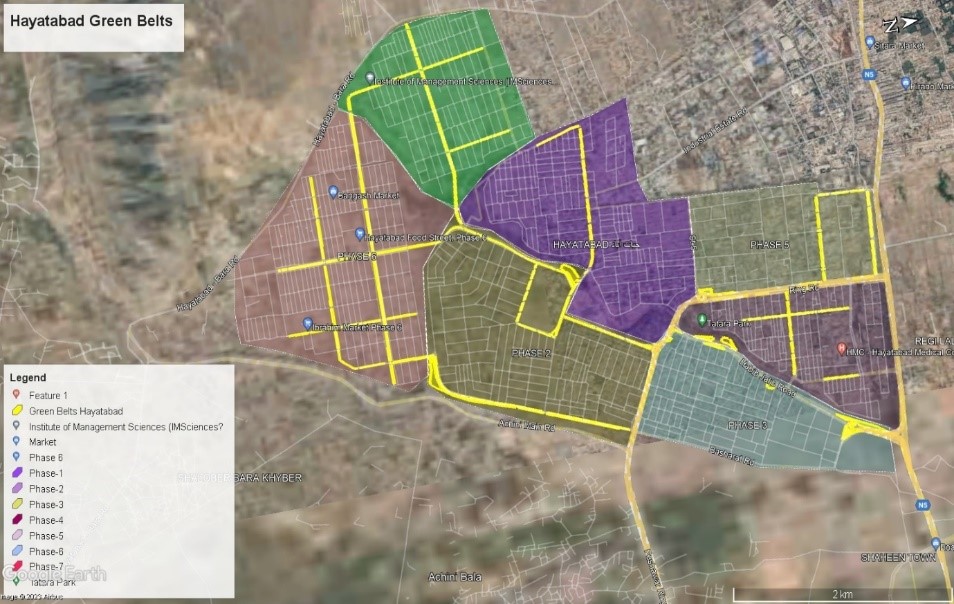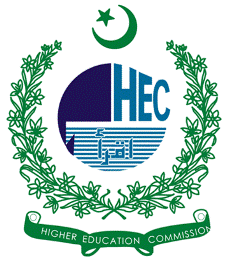Reuse of Ablution Water for Landscaping in Hayatabad Peshawar - A Step Towards Climate Change Adaptation
Keywords:
Ablution Water Reuse, COD, BOD, Groundwater Conservation, Energy Efficiency, SDGsAbstract
Rapid urbanization and climate change have intensified water scarcity challenges in Pakistan, particularly in cities like Peshawar. This study assesses the feasibility of reusing mosque (masjid) ablution water to irrigate nearby green belts in Hayatabad, Peshawar, as a cost-effective and sustainable alternative to conventional tubewell irrigation. Spatial analysis showed that most green belts are located within a 450-meter radius of mosques, enabling the use of low-energy pumping systems. Economic analysis indicated that reusing ablution water could reduce daily transport and pumping costs by more than thirteenfold, significantly decreasing fuel consumption and greenhouse gas emissions. Water quality tests found that ablution water had BOD levels of 4.6–6 mg/L and COD of 10–12 mg/L, remaining within acceptable limits for non-potable irrigation use. Overall, the results demonstrate that the reuse of ablution water is technically feasible, environmentally beneficial, and aligns with Sustainable Development Goals (SDG 6 and SDG 13). This approach offers a scalable model to improve urban water resilience and reduce pressure on groundwater resources in water-stressed regions
References
H. Rasheed, “Drinking water quality in Pakistan: Current status and challenges,” Pakistan Counc. Res. water Resour. (PCRWR), Islam., vol. 141, 2021.
N. Maqbool, “Pakistan’s Urban Water Challenges and Prospects,” Pak. Dev. Rev., vol. 63, no. 3, pp. 417–430, 2024, doi: 10.30541/V63I3PP.449-462.
K. B.-M. Ziad Al-Ghazawi, Ahmad Qasaimeh, “Ablution gray water qualitative assessment and treatment by submerged membrane bioreactor: a case study in Jordan,” Desalin. Water Treat., vol. 127, pp. 213–221, 2018, doi: https://doi.org/10.5004/dwt.2018.22790.
“Impact of Climate Change on Water in Pakistan,” https://pide.org.pk/.
M. Rizwan et al., “Simulating future flood risks under climate change in the source region of the Indus River,” J. Flood Risk Manag., vol. 16, no. 1, p. e12857, Mar. 2023, doi: 10.1111/JFR3.12857.
J. Raček, “Gray Water Reuse in Urban Areas,” Springer Water, pp. 195–217, 2020, doi: 10.1007/978-3-030-18359-2_8.
N. S. & K. U. R. Shayan Ameer, Nisar Muhammad, Khan Zaib Jadoon, “A systematic literature review on potential of ablution greywater reuse: current insights, challenges, and future prospects,” Appl. Water Sci., vol. 15, no. 173, 2025, doi: https://doi.org/10.1007/s13201-025-02488-0.
R. DeFries and K. N. Eshleman, “Land‐use change and hydrologic processes: a major focus for the future,” Hydrol. Process., vol. 18, no. 11, pp. 2183–2186, Aug. 2004, doi: 10.1002/HYP.5584.
M. U. S. Saimar Pervez, Laiba Ahmed, Adeel Asif, Khawaja Zawar Ahmed, Kamran Manzoor, Babar Abbas, “Development and Application of Low-Cost Filtration System for the Treatment of Greywater of a Mosque,” Tech. J. , UET Taxila, vol. 3, 2024, [Online]. Available: https://tj.uettaxila.edu.pk/index.php/technical-journal/article/view/2066
S. L. Shen, H. M. Lyu, A. Zhou, L. H. Lu, G. Li, and B. B. Hu, “Automatic control of groundwater balance to combat dewatering during construction of a metro system,” Autom. Constr., vol. 123, Mar. 2021, doi: 10.1016/J.AUTCON.2020.103536.
R. M. S. Radin Mohamed, A. Al-Gheethi, J. A. Rahman, A. H. Mohd Kassim, and S. Musa, “Reuse of Ablution Water to Improve Peat Soil Characteristics for Ornamental Landscape Plants Cultivation,” MATEC Web Conf., vol. 103, Apr. 2017, doi: 10.1051/MATECCONF/201710305003.
M. Abbas, P. G. Atangana Njock, and Y. Wang, “Influence of Climate Change and Land-Use Alteration on Water Resources in Multan, Pakistan,” Appl. Sci. 2022, Vol. 12, Page 5210, vol. 12, no. 10, p. 5210, May 2022, doi: 10.3390/APP12105210.
Nazish Huma Khan, Mohammad Nafees, Tooba Saeed, Fazli Zuljajal, “Marble Production and Environmental Pressure: A Case Study of Hayatabad Industrial Estate Peshawar, Pakistan,” Res. Sq., 2023, [Online]. Available: https://www.researchsquare.com/article/rs-3244303/v1
Z. W. Kundzewicz, V. Krysanova, R. E. Benestad, Hov, M. Piniewski, and I. M. Otto, “Uncertainty in climate change impacts on water resources,” Environ. Sci. Policy, vol. 79, pp. 1–8, Jan. 2018, doi: 10.1016/J.ENVSCI.2017.10.008.
H. M. Lyu, S. L. Shen, Y. X. Wu, and A. N. Zhou, “Calculation of groundwater head distribution with a close barrier during excavation dewatering in confined aquifer,” Geosci. Front., vol. 12, no. 2, pp. 791–803, Mar. 2021, doi: 10.1016/J.GSF.2020.08.002.
G. E. Moglen and G. E. Rios Vidal, “Climate Change and Storm Water Infrastructure in the Mid-Atlantic Region: Design Mismatch Coming?,” J. Hydrol. Eng., vol. 19, no. 11, Nov. 2014, doi: 10.1061/(ASCE)HE.1943-5584.0000967.
Roubi Zaied, “Water use and time analysis in ablution from taps,” Appl. Water Sci., 2016, [Online]. Available: https://www.academia.edu/75178414/Water_use_and_time_analysis_in_ablution_from_taps

Downloads
Published
How to Cite
Issue
Section
License
Copyright (c) 2025 50sea

This work is licensed under a Creative Commons Attribution 4.0 International License.




















